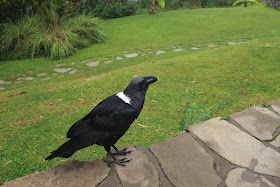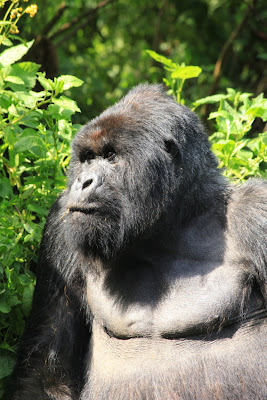This is the Sand River which flows east into the Indian Ocean at Maputo in Mozambique
The Sand River had a huge flood on January 19 of this year and as the flood waned, the bed of the river was so choked with sand that no water was flowing on the surface - it was moving within the sand body that was deposited on the bedrock!
Our morning game drive encountered impala up ahead in the road
This was a bachelor herd composed of all young males. They certainly are graceful looking (and we ate some of it later that night - a very light colored meat that resembled chicken but tasted more like red meat).
We also spotted three rhino's along the way
Populations of this threatened species have turned around and they are not that hard to spot here. Conservation efforts have paid off but illegal poaching for their horns is still a problem.
A golden orb spider on its web
The Cape buffalo was seen wallowing in a muddy pool
This is the animal that the American bison was mistakenly named buffalo
A nyala male
And a young one. The wildlife was everywhere to be seen on this reserve. The last time I was here was during the dry season and the trees were leafless. It was totally different this time. Nothing could prepare for what we saw next. Our driver and guide sped away at a high rate of speed on the dirt track. Obviously, one of the other guides had spotted something unusual.
When we arrived at the scene, we saw four young male lions that had just taken down a Cape buffalo. The prey was still alive when we arrived. The scene was gruesome in many respects but this we knew was how nature worked. The lion needed food and this is the law of the land. Some animals eat others. Graphically, it was bloody but our guide told us how lucky we were to see this. He himself had not seen a kill in over 11 months. Here you can see one of the lions eating the testes of the buffalo, while the other three hold it down. One of the lions had put its mouth completely around the muzzle of the buffalo to suffocate it. It was an unbelievable scene!
After the buffalo expired, the lions got to work.
They moved toward the gut area to remove the easy stuff with bone
It was amazing to see how they worked together. We were here for about 1.5 hours watching it all unfold. The guide gave great commentary about what was happening the whole time and took pictures himself - a testament to how unusual it is to see something like this.
We were very close to this awesome scene!
Meanwhile, back at the ranch.... This is the entrance to our hotel, the Singita Lodge on the Sand River
The entrance sign says it all - this is wild country and you should not wander off anywhere with an armed escort. We were escorted to our rooms after dark as animals have been known to roam into the property at night (rare).
It is very tastefully appointed
Above the bank of the river. I'll post more more pictures of this amazing property after we arrive at our next stop - the Maldive Islands.






































































